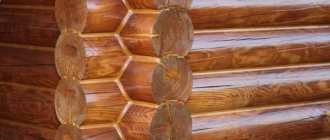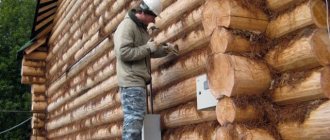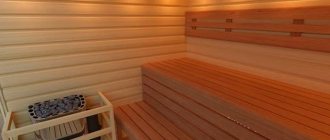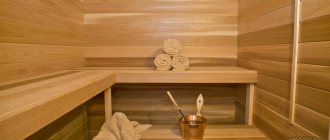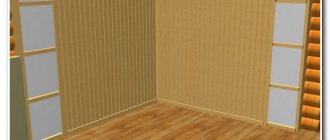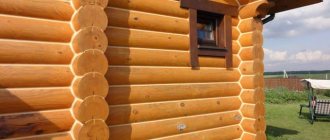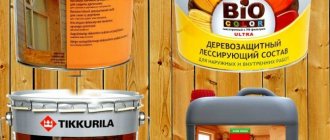Hi all! It is important for every homeowner that his territory, as well as all buildings, are not only reliable and durable, but also always look good. This also applies to the bathhouse. Since they are most often built from wood, a logical question arises - how to treat the outside of the bathhouse frame.
There are many reasons to love saunas. These are health benefits, an opportunity to relax your soul and body, pleasant company, etc.
But as the owner of a bathhouse, you need to clearly understand how important it is to care for it, as well as to provide protection from internal and external factors.
Today we are talking about how to paint the outside of a bathhouse. If you are interested, I will tell you separately how to treat the log house, but from the inside.
Processing agents used
Speaking about how to treat the exterior of a log house bathhouse, many believe that it is enough to apply a couple of layers of varnish or paint, and everything will be great.
This is wrong. Firstly, a log house is used for construction. And this is natural wood. With its own strengths and weaknesses. Secondly, the bathhouse is a place with a high level of humidity. And you need to protect not only from the inside, but also from the outside.
Thinking about how to process the log house, the builders came to the conclusion that such structures require 3 stages of processing.
- Antiseptics
. It is mandatory to treat the outside of the log house with antiseptic agents. They are aimed at protecting against moisture, mold, and mildew. Otherwise, moisture will be absorbed into the wood, linger there, and cause deformation. Antiseptics have special properties that allow them to penetrate deep into the wood structure; - Fire retardants
. When thinking about how to cover the outside of the bathhouse, do not forget that wood is a flammable material. And this property must be suppressed. This is done with the help of fire retardants. That is, fire-fighting compounds. They are also used for internal processing; - Pest protection
. A separate type of protective impregnation that prevents the appearance of various insects and other pests in wood.
Paint and varnish are more of a finishing touch. But they have not only decorative properties. External bath paint or varnish is also used. They create a dense protective film on the surface, and also provide an attractive appearance and its preservation for a long time.
Even if an old log house is being treated, it is necessary to apply an antiseptic, a fire retardant, and only then layers of paint or varnish.
It is worth noting that now, when a log bathhouse is being treated inside and outside, complex formulations are increasingly being used. These are special mixtures with antiseptic and fire retardant properties.
Types of compositions for interior work
We have already said a lot above about various impregnations, but it’s time to clarify what exactly you may find on sale.
We will separately consider water-repellent and antiseptic impregnations.
Mixtures for wood: with wax and oil
Pure wax for impregnating wood is used in limited cases. This operation is called waxing, it is applicable to furniture, but our case is different.
The task of water-repellent impregnation is inherent in its name. In addition, it allows the wood not to absorb dirt, sweat and grease. Another couple of important advantages are a reduction in the swelling of wood (you don’t think that after impregnation it will completely stop absorbing moisture? In fact, its amount will become much less), as well as an increase in its elasticity, that is, it will not crack after drying.
Therefore, the basis of impregnation is oil. It comes in flax and paraffin.
ATTENTION! Teak and tung oils are not used, because tung is toxic, and it is part of teak.
Paraffin oil is made from petroleum. It is as safe as flaxseed. In particular, paraffin oil can be bought from Tikkurila, it is called “Supi Laudesuoya”.
Impregnation for shelves in the Tikkurila steam room - Supi Laudisuoja. Banka Photos
By the way, the same company has an impregnation for baths inside with wax, which is called “Supi Saunavaha”. Water-soluble, which means that there is not only wax, but also something that polymerizes when it dries. There are no ingredients on the label.
Flaxseed oil is more traditional, it can be found in many varieties, both domestic and imported. You can buy pure raw (or boiled) flaxseed oil at a pharmacy or in a regular supermarket. Even in this form it can be used as an impregnation, but it will take three days to dry one layer.
Usually the buyer is offered a composition that requires much less time to dry. Boiled butter requires less time to polymerize. Dryers also reduce time, but their use here is inappropriate.
The mixture of oil and wax is called oil wax. Such compositions can be of varying degrees of solid-liquid. Liquid formulations are more convenient to apply, but they have higher consumption.
There are a lot of impregnations. Almost every company that has something for a bath produces such impregnations. Therefore there is no need to list. Decide what is more important to you - price or the authority of a large company. And so, by and large, even what you can do with your own hands will be of very good quality. You use natural ingredients.
Antiseptics
You can also learn about what types of antiseptics can be found on the market from this article of ours. However, here we will briefly go through some of the major market players that everyone knows about.
"Senezh"
produces a whole range of antiseptics that can be used for both internal and external work, that is, you have the opportunity to buy everything you need to protect wood from this company.
Impregnation Senezh and brush
Structural parts such as joists and beams that will not be visible can be treated with a strong, non-washable antiseptic. For example, “Senezh Ultra”, “Senezh”, “Senezh Bio”.
Non-washable is not suitable for facades, because it gives a green color to copper salts. Therefore, weaker compounds are used, but they do not produce coloring (at least in unnatural colors). For example, "Senezh Aquadecor".
Inside, you should use even safer options, which are marked that they are suitable for interior work - “Senezh Ecobio” .
“Senezh Sauna” was developed . To stand out in the market, they added antimicrobial agents. But it is not recommended to use this antiseptic on shelves.
"Neomid"
The products of this company are widely advertised and are known to many. For baths, she has developed such impregnations as “Oil for baths and saunas” - already with an antiseptic, as well as the composition “Neomid 200” , which is suitable for antiseptic steam rooms.
Antiseptic for baths and saunas NEOMID 200, 0.5 l., concentrate. Photo by Maxidom
The rest of the impregnations from this manufacturer are universal for any interior and exterior work. In particular, to protect wood from biological damage, you can use Neomid 400 Neomid 440 outside
There are other options in the catalog on the company’s website that are suitable for building elements under heavy-duty conditions. As well as a series of comprehensive protection against fire and biological damage. Below is a video about using this manufacturer's anti-mold composition.
"Tikkurila"
Well, this name is definitely on everyone’s lips. We have already mentioned their impregnations for baths and saunas inside. Let us repeat - these are “Supi Laudesuoya” and “Supi Saunavaha”.
In addition, the company offers oil for shelves, as well as protective compounds for walls and ceilings, but they are no longer impregnations, but acrylic varnishes. Antiseptic additives are already included in these formulations - “Supi Arctic” and “Supi Saunasuoya”.
For the floor they have Supi Lattiaoljy .
Choice of antiseptic
As you understand, treating the outside of a log bathhouse necessarily involves the use of antiseptics.
But the treatment of a log house, like a bathhouse, involves the use of certain antiseptics. Therefore, you first need to study the range and understand what impregnation for the outside of a bath will be effective.
- Easily washable compounds are not suitable for external use. They can be used in the rest room, as well as in the dressing room. But they are not used for steam rooms and exterior decoration. This is largely due to the presence of metal salts, which wash out such an antiseptic from the wood;
- Only hard-to-wash antiseptics are suitable for exterior finishing. They contain natural as well as synthetic oils;
- Steam rooms use fast-acting substances. They have a high level of antifungal protection. Plus they can withstand high temperatures.
Antiseptic treatment of a log house can be performed using 2 types of products:
- Colored
. They are able to paint wood in the chosen color and shade. Easy to apply. There are no significant disadvantages; - Colorless
. They are much harder to apply. But a significant advantage lies in the ability to preserve the original appearance of the wood.
If you are treating a log house or a log bathhouse, but you do not want the structure to darken over time, remember one nuance. Every 1.5-2 hours you need to change the brush with which antiseptics are applied. But it is best to use spray bottles. Leave the brushes for applying products to hard-to-reach areas.
Painting a bathhouse: step-by-step instructions
- Preparing for painting
- Exterior painting
- Dye
- Varnish
The walls of the bathhouse need protection from temperature changes, exposure to precipitation and ultraviolet radiation
In order to provide the walls with maximum resistance to negative factors, impart aesthetic appeal and extend the service life of the bathhouse, it is important to choose the right coloring composition and correctly paint the surface.
Products for exterior painting of baths
Selection of paints for painting a bath
- Oil paint
. Very sensitive to sunlight. It is used quite rarely for painting wooden baths. Price - from 400 rubles per liter. - Alkyd paint
. It comes in oil-based and varnish. To paint a log house, it is better to use enamel paint based on varnish. Price - from 300 rubles per liter. - Emulsion paints
. This class includes water-based, water-dispersed, and acrylic compositions. The last two options are the optimal solution for exterior painting of a log bathhouse. They allow the wood to “breathe”, do not contain harmful chemical solvents and are well diluted and removed with water until they polymerize on the surface. They are not afraid of the sun's rays; these paints are quite durable. The cost of 1 liter is from 650 rubles.
Choosing a varnish to cover a bath
- Alkyd
. Used for external and internal work. Very durable and moisture resistant. The downside is that it takes a long time to dry. Price - from 700 rubles per liter. - Acrylic
. It is believed that varnishes of this type are the most environmentally friendly. They are fireproof, durable and elastic. Retains the original appearance of wood for many years. Price - from 200 rubles per liter. - Epoxy
. This category of varnishes is waterproof and resistant to mechanical and chemical factors. They dry quickly and are widely used for exterior finishing work. From 350 rubles per 1 liter. - Polyurethane
. These varnishes are rightfully considered one of the most popular. Very resistant to abrasion, mechanical damage, and chemical attack. A wide range of these varnishes allows you to choose the one suitable for exterior wood finishing work. Cost - from 1200 rubles per liter.
Exterior painting technology for a wooden bath
Rules for painting bath walls with paint
- We cover areas that do not require painting.
- Next, you should make sure that the caulking material is tightly packed into the cracks.
- Apply the first layer of paint with a brush, roller or spray. We paint the walls, holding the sprayer at a right angle and moving it evenly. Let the paint layer dry.
- Carefully sand the painted surface to remove any lint that appears.
- If painting is done with a sprayer, then at the bottom we change the angle of inclination to completely cover the entire surface with paint.
- Apply another layer of paint.
Features of painting a bathhouse with varnish
When choosing a tool, keep in mind that after painting with a brush or roller, the surface acquires a matte texture. At the same time, spray painting gives the walls a glossy look. Apply the first layer of varnish. For this it is better to use a spray bottle. After this coating, there will be fewer unevenness than after working with a brush.
Do not forget to cover items that do not require painting with a protective cloth. Sand the surface after complete drying. We open the wall with a second layer, paying special attention to the seams and corners. Try to keep the spray gun at approximately the same distance from the surface during the entire process.
tutknow.ru>
Processing procedure and rules
You have already decided how to treat the outside of the house or bathhouse. We selected antiseptic agents and purchased fire retardants.
When processing a log bathhouse from the outside, the sequence of applied compounds should be as follows:
- antiseptics against fungus, mold and moisture;
- protective agents against insects and other pests;
- flame retardants.
This is the order that needs to be followed. Otherwise, you can level out the properties of all purchased compounds.
The impregnation itself for the outside of the bath is carried out according to the following rules:
- To achieve the maximum effect from the applied protective agents, it is recommended to treat the log house with crowns before assembly;
- Before application, it is important to remove all debris, dust, dirt, etc. from the wood. Use a vacuum cleaner, brushes, brooms;
- Make sure the log house or sauna is dry enough. It is impossible to process wet wood;
- Use sandpaper or sanders. And then decide how to process the log house after sanding;
- Since moisture can penetrate deep into the pores of the material, the treatment of a log house, like a bathhouse, should be carried out from the outside, as well as from the inside;
- Before applying protective compounds, do not melt the bathhouse. That is, it should be at natural room temperature.
There is another option than to treat the outside of the log house. These are products designed to protect against sunlight and ultraviolet rays.
When exposed to solar radiation, the resins in the wood itself, as well as coatings, can be burned out. Over time, this will cause the material to age and lose color.
Painting the outside of a log house: factors affecting quality
The quality of painting a wooden country house depends mainly on two factors:
- Weather. Ideal weather is dry and windless. Do not paint in the sun (the paint will dry too quickly and unevenly), during or after rain. The permissible temperature is determined by the type of paint (indicated on the label).
- Wood moisture content. It should not exceed 20% during painting, so façade walls made of wood with natural humidity are painted after the frame has shrunk.
A necessary condition for a quality result is ease of use. Source projecty-domov.ru
Following several rules will help make the painting of a log house durable:
- Ends of logs. They are treated with lime or water-based paint for the first time immediately after cutting the log house (this prevents the logs from drying out suddenly and reduces cracking). After sanding, the ends are painted at least 3-4 more times.
- Tool. A spray gun helps to apply paint quickly and evenly if you have experience. Otherwise, a wide brush with a dense padding will be the best choice. The paint is applied with a brush in the longitudinal direction (according to the location of the crowns of the log house).
- Working methods. If necessary, intermediate manual sanding with re-application of primer is allowed. The glazing or covering antiseptic should be stirred periodically during operation; this will help the pigment to distribute evenly.
Painting of the wooden house is completedSource yandex.ru
Protective Equipment Options
See also
Insulation of a frame house: materials, step-by-step instructions
Now some examples of how to cover a wooden bathhouse.
I think many people have noticed that houses painted with Tikkurila and other high-quality compounds look beautiful and also retain their attractive appearance longer. An equally important aspect is the level of protection.
As a protective means, I can say that treating the outside of a log bathhouse with the following compounds will be the right decision:
- Tikkurila;
- Senezh;
- U-409;
- Eurotex-Sauna;
- Pinotex Classic Plus;
- Neomid 435 Eco;
- VGT Biosecurity, etc.
By the way, quite a lot is known about Pinotex wood protective products. Repeatedly used for personal purposes and on objects.
The need for antiseptic and decorative work in baths
In spring, together with nature, tree insects awaken, which pose a great threat to trees. They use wooden material for food, using it as fiber or as a shelter. At this time, the wood of the bathhouse is more exposed to fungi and mold, because The air humidity is constantly high, it rains periodically, and the snow melts. All this greatly impairs the strength of the log crowns.
And in the summer, under the influence of ultraviolet rays and rain, the wood of the bathhouse undergoes so-called aging; it darkens and acquires a gray tint. Cracks may form on its surface, into which moisture enters, and along with it, putrefactive processes are formed and fungus develops, which in a short time can destroy the entire structure.
To prevent the appearance of biological pests, it is necessary to impregnate all external and internal walls, ceilings, floors, shelves, doors and benches with protective compounds. Otherwise, the fungus may develop on the untreated surface and successfully spread in the future. After all, there are species that can develop on healthy wood. Before choosing antiseptic and other protective compounds, you need to understand that to treat the outer walls of the bathhouse you need to purchase the same compounds; they are not afraid of exposure to the sun, wind, rain, etc. And for treating interior walls, there are completely different compositions that can protect wood from destructive constant moisture and elevated air temperatures.
Choice of paint and varnish
See also
How to calculate the area of the attic: online calculator and roof calculations
Antiseptic and fire protection treatment of the outside of a log bathhouse is important. But it is equally important to then coat the wood with paint or varnish. And at least 2 layers.
A bathhouse is not quite the same as painting imitation timber, since the material, as well as the operating conditions, are somewhat different.
When thinking about how to paint a log bathhouse on the outside, you usually choose among the following options:
- Oil paints
. The most affordable. But they are not environmentally friendly. Plus the service life is insignificant. That’s why I don’t recommend taking it; - Alkyd varnishes and paints
. One of the best options for baths, as well as exterior wood finishing. There are no toxins or solvents in the composition. Durable, durable, vapor permeable. They also have a wide palette of shades. Color fading does not occur over time; - Scuba diving
. They contain acrylates, resins and dispersions. Eco-friendly and beautiful in appearance. But they are inferior in durability; - Oil waxes and clear varnishes
. The main advantage is the ability to preserve the original appearance of the material. But you can’t count on a high level of protection; - Acrylic paints.
Perhaps the best paint option for wood, which is ahead of even alkyd analogues. They are offered in a large assortment, are environmentally friendly, odorless, do not cause allergies and fit perfectly on a wooden surface. The disadvantage is the high price.
And then decide for yourself how to paint the outside of the timber bathhouse.
I don’t think it’s worth mentioning how to paint a bathhouse.
Peculiarities
Caulking a bathhouse is a procedure carried out to minimize heat loss during the further operation of the structure. During the caulking process, the cracks, joints and gaps between the logs of the log house are filled with heat-insulating material (inter-crown insulation). As a result:
- the volume of heat loss during operation of the bath is reduced;
- the time for kindling and warming up the premises is reduced;
- fuel and electricity costs are reduced.
Caulking is a procedure that is carried out repeatedly throughout the construction of the bathhouse. This is due to the fact that the process of building a structure is accompanied by natural drying of the logs and gradual shrinkage of the log house, as a result of which new cracks may form in different parts of the bathhouse.
This procedure is carried out in two ways - stretching and dialing. In the first case, the insulation is placed in the cracks with fibers across, leaving an edge of the material 4-5 centimeters wide outside. Then this edge is rolled up with a roller, which is tucked into the cracks with a chisel.
In the second case, the insulation fibers are twisted into tight strands, which are pushed into the cracks between the logs using a chisel.
Reviews
On our site there is a bathhouse made of rounded logs, built a year ago. We understood that without additional protection it would not serve us for long, so we tried to immediately provide it. Before covering wooden surfaces in the bathhouse, all dirt, resin, grease and other contaminants were removed. We used Neomid Sauna varnish inside the sauna; it is safe for the health of sauna visitors and has low thermal conductivity, which prevents burns when the skin comes into contact with the treated wooden surface. It protects wood from dust, dirt, moisture, and most importantly from biological contamination. This varnish has a high cost, but also excellent quality, we have already seen this.
The exterior of the bath house was antiseptically treated with a composition from the same company Neomid, and this year the walls were painted with a decorative glaze compound. Thus, we additionally protected the bathhouse crowns from the sun, precipitation, fungus formation, etc. We visit the bathhouse several times a week, every day in the summer, despite this, the wooden surfaces in the room remain unchanged due to constant moisture.
Sergey Buravtsev, 27 years old (Kostroma).
A Russian person and a real bathhouse built from wooden material are two inseparable concepts. Only in such a sauna can you relax your soul, restore your strength, and inhale natural beneficial substances. But if you do not take care of the log house and do not carry out preventive work using antiseptic and other protective compounds, then visiting the bathhouse can be harmful to health, and the structure itself will not last a dozen years.
